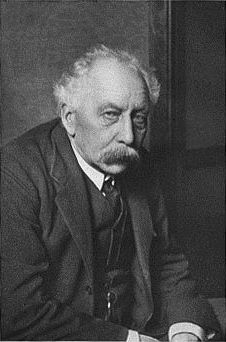Modern synthesis (20th century) facts for kids
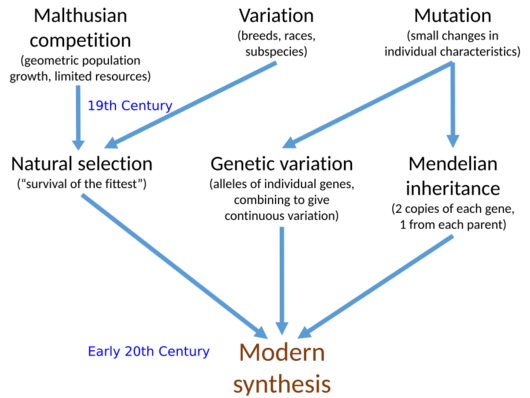
The modern synthesis is a really important idea in biology. It brought together Charles Darwin's theory of evolution with Gregor Mendel's discoveries about how traits are passed down (heredity). This happened in the early 1900s.
A scientist named Julian Huxley first used the term "modern synthesis" in his 1942 book, Evolution: The Modern Synthesis. This new way of thinking combined several key ideas:
- Natural selection: How nature chooses which traits help living things survive.
- Mendelian genetics: How parents pass on specific traits to their children.
- Population genetics: How genes change within a group of living things over time.
The modern synthesis also helped connect big changes in evolution (called macroevolution, seen by scientists who study fossils) with small changes happening in groups of living things every day (called microevolution).
Many scientists helped shape this idea. Some important names include Ernst Mayr, G. Ledyard Stebbins, and Theodosius Dobzhansky. They all agreed that natural selection is key, working on new traits that appear through mutations.
Contents
How the Idea of Evolution Grew
Darwin's Big Idea: Natural Selection

In 1859, Charles Darwin wrote his famous book, On the Origin of Species. Most scientists then believed that evolution happened, meaning living things changed over time. But they weren't so sure that natural selection was the main way it happened.
In those days, other ideas were popular. Some thought that traits gained during life could be passed on (like Lamarckism). Others believed evolution happened in big jumps (saltationism) or was driven only by new mutations (mutationism). Darwin himself even thought some Lamarckian ideas might be true.
Why Scientists Doubted Darwin (for a bit)
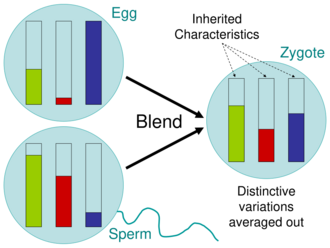
From the 1880s, many biologists started to doubt parts of Darwin's theory. This time was called the "eclipse of Darwinism." One big problem was Darwin's idea of how traits were inherited. He thought it was like mixing paints – a "blending inheritance."
If blending were true, any new helpful trait would get weaker by half in each generation. It would quickly disappear. This would make it impossible for natural selection to work on small changes. Also, Darwin's idea of "pangenesis" (tiny particles from the body going to the reproductive parts) seemed to support the idea that changes during life could be inherited.
Weismann's New Idea: Germ Plasm
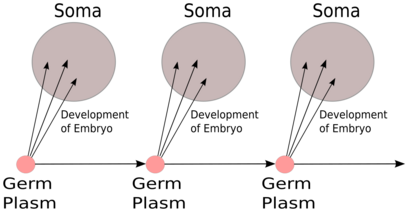
In 1892, August Weismann had a different idea. He said that the material that carries traits (he called it the germ plasm) is separate from the rest of the body. The germ plasm forms the body, but the body cannot change the germ plasm.
This meant Darwin's pangenesis was wrong, and Lamarckian inheritance (passing on acquired traits) was impossible. Weismann even cut off the tails of mice for generations and showed their babies still had normal tails. This proved that traits were "hard" to change and not easily influenced by the body. His strong arguments helped create more anti-Darwinian feelings, adding to the "eclipse."
New Discoveries That Helped
Mendel's Genes and Early Genetics
Around 1900, scientists like Hugo de Vries and Carl Correns rediscovered Gregor Mendel's work. Mendel showed that traits are passed down in specific, separate units, not by blending. For example, if you cross round peas with wrinkled peas, you get all round peas in the first generation. But if you cross those, you get about 3/4 round and 1/4 wrinkled peas. The traits don't blend; they stay distinct.
This discovery led to a debate. Some scientists, called Mendelians, thought evolution happened in big jumps because traits were discrete. Others, called biometricians, thought variation was continuous and gradual, like Darwin believed.
However, some early geneticists, like William Bateson and Udny Yule, soon realized that Mendel's ideas could explain continuous variation if many genes were involved. This helped bridge the gap between the two groups.
Castle's Rats and Morgan's Fruit Flies

In 1906, William Castle studied coat color in rats. He showed that by selecting for bigger or smaller stripes, he could change the rats' traits far beyond their original range. This proved that continuous variation could be inherited and changed by selection, going against some earlier ideas.
Then, in 1912, Thomas Hunt Morgan worked with fruit flies (Drosophila melanogaster). He found that mutations didn't create new species in one go. Instead, they added to the genetic differences in a group. Morgan showed that Darwinian evolution could work on these small, distinct Mendelian changes, just as if the variation was continuous. This opened the door for geneticists to see how Mendel's ideas supported Darwin's.
Key Parts of the Modern Synthesis
Math and Genes: Population Genetics
In 1918, R. A. Fisher showed how continuous variation (like height) could come from many separate genetic locations. His 1930 book, The Genetical Theory of Natural Selection, explained how Mendel's genetics fit perfectly with Darwin's natural selection.
In the 1920s, J. B. S. Haldane studied real-world examples of natural selection, like the color changes in peppered moths. He showed that natural selection could work very quickly. These scientists wanted to make biology as precise as physics, using math and experiments. Natural selection, once hard to prove, became something that could be predicted and tested.
Wright's Fitness Landscape
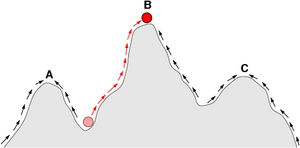
The scientist Sewall Wright focused on how different genes work together. He also looked at how small, isolated groups of living things could be affected by genetic drift (random changes in gene frequency). In 1932, he introduced the idea of an "adaptive landscape."
This landscape showed peaks (where living things are very well adapted) and valleys (where they are less adapted). Wright's model helped explain how groups could move away from one peak and then be pushed by natural selection towards a new, better one. This idea was very helpful for scientists studying real groups of animals in nature.
Dobzhansky's Evolutionary Genetics
Theodosius Dobzhansky, who worked with Morgan's fruit flies, was one of the first to study genetics in wild populations. His 1937 book, Genetics and the Origin of Species, was a huge step. It explained the complex math of Fisher, Haldane, and Wright in a way that other scientists could easily understand.
Dobzhansky also stressed that evolution was based on real, physical genes located on chromosomes. He showed that real groups of living things had much more genetic variety than earlier scientists thought. He argued that natural selection not only drives change but also helps keep this genetic variety in a group.
Ford's Ecological Genetics

E. B. Ford was a naturalist who wanted to test natural selection in nature. He basically created the field of ecological genetics. He studied wild groups of butterflies and moths and showed that Fisher's predictions were correct. In 1940, he defined "genetic polymorphism" (when a group has different forms of a trait). His work helped convince Dobzhansky to focus more on selection in his famous textbook.
Schmalhausen's Stabilizing Selection
Ivan Schmalhausen developed the idea of stabilizing selection. This is when natural selection works to keep a trait at a certain value, removing individuals that are too different from the average. He published his ideas in 1941 and 1945. He observed that most new mutations are harmful, and stabilizing selection helps remove them. Dobzhansky called his work "an important missing link" in understanding evolution.
Huxley's Popular Book
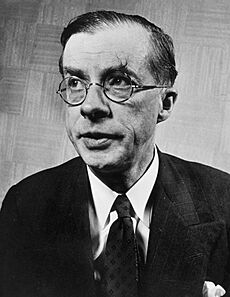
In 1942, Julian Huxley wrote Evolution: The Modern Synthesis. This book gave the whole idea its name and helped make it popular. He wanted to combine many sciences: genetics, ecology, paleontology, and more. Huxley believed that natural selection was a "fact of nature" that could be proven by observation and experiments. He saw the 1920s and 1930s as a "period of synthesis" that made biology a more unified science, like physics.
Mayr's Speciation Ideas
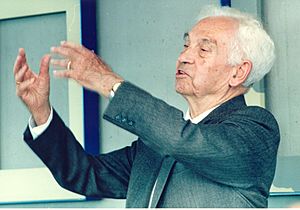
Ernst Mayr's 1942 book, Systematics and the Origin of Species, was another key part of the synthesis. He stressed how important population differences are in evolution, especially in how new species form. Mayr focused on "allopatric speciation," which means new species form when groups are separated by geography (like a mountain range or ocean). He thought this geographic separation was needed for groups to become so different that they could no longer breed with each other.
Mayr also created the "biological species concept." This defines a species as a group of living things that can breed with each other and produce fertile offspring, but cannot breed with other groups.
Simpson's Palaeontology
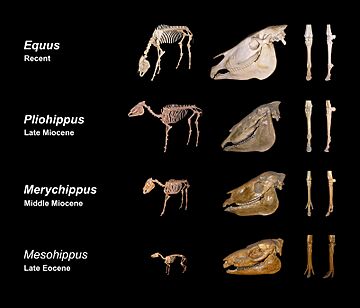
George Gaylord Simpson showed that the modern synthesis worked well with paleontology (the study of fossils). His 1944 book, Tempo and Mode in Evolution, was very important. Many paleontologists had disagreed with natural selection as the main way evolution happened. They saw straight-line trends in the fossil record (like in evolution of the horse) and thought it supported other ideas.
Simpson showed that these "straight-line" trends weren't really straight. The fossil record actually showed an irregular, branching pattern, which fit perfectly with the modern synthesis's predictions.
Bringing Scientists Together
In 1946, a group of scientists formed the Society for the Study of Evolution. This group, including Mayr, Dobzhansky, and Wright, helped bring together genetics and evolution into one unified science. They believed that Darwinism was "reborn" and evolutionary biology was now a strong, accepted field.
Stebbins's Botany

The botanist G. Ledyard Stebbins brought plants into the modern synthesis. In his 1950 book, Variation and Evolution in Plants, he explained how hybridization (when different species breed) and polyploidy (when cells have extra sets of chromosomes) are important for speciation in plants. Polyploidy, in particular, can create new species almost instantly.
After the Modern Synthesis
After the main ideas of the modern synthesis came together, evolutionary biology kept growing. Many new discoveries and ideas have been added.
Hamilton's Inclusive Fitness
In 1964, W. D. Hamilton introduced "inclusive fitness." This idea says that a living thing's success isn't just about how many offspring it has directly. It also includes how many offspring it helps its relatives have, because relatives share many of the same genes. This led to the idea of "kin selection."
Williams's Gene-Centered View
In 1966, George C. Williams wrote Adaptation and Natural Selection. He argued for a "gene-centered view of evolution." This means that natural selection works by changing how often different alleles (versions of a gene) appear in a group. He argued that selection doesn't work on whole groups of animals. This idea was made very popular by Richard Dawkins in his 1976 book, The Selfish Gene.
Wilson's Sociobiology

In 1975, E. O. Wilson wrote Sociobiology: The New Synthesis. He tried to bring the study of animal societies into the evolutionary framework. This field, called sociobiology, looked at how social behaviors (like ants living in colonies) could evolve through natural selection. By 2000, many of these ideas had become part of evolutionary psychology.
Lewis's Homeotic Genes
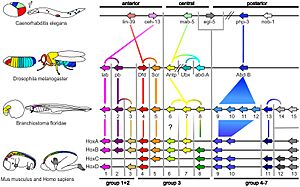
Starting in 1977, new technology allowed scientists to study how genes control development. This led to the field of evolutionary developmental biology (often called "evo-devo"). In 1978, Edward B. Lewis discovered homeotic genes. These are "toolkit genes" that control how other genes work during development.
Evo-devo showed that some of these control genes are incredibly old. For example, insects and mammals use similar genes to form their eyes. This "deep homology" gives strong evidence for evolution and shows how different animals can share basic building plans.
New Ideas and Future Syntheses
By the late 1900s, some scientists felt the modern synthesis was getting old. They proposed new "syntheses" to add new discoveries and fill in gaps. These new ideas include:
- Epigenetic inheritance: Changes in gene activity that can be passed on without changing the DNA itself.
- Niche construction: How living things change their environment, which then affects their own evolution.
- Symbiogenesis: How new species can form when different organisms live together and become one.
- Horizontal gene transfer: When genes are passed directly between organisms, not just from parent to offspring.
Some scientists, like Eugene Koonin, even talk about a "post-modern" synthesis. This new synthesis would include huge changes from molecular biology, the study of tiny organisms like prokaryotes, and genomics (the study of all an organism's genes). For example, horizontal gene transfer between bacteria shows that these tiny organisms can share genes freely, which doesn't fit neatly into the older synthesis.
Many biologists now agree that the modern synthesis was a great start, but it needs to keep growing. They want a new synthesis that brings together all parts of biology related to evolution, adaptation, and the huge variety of life on Earth.
Images for kids
-
Darwin's pangenesis theory.
-
Blending inheritance, implied by pangenesis, causes the averaging out of every characteristic, which as the engineer Fleeming Jenkin pointed out, would make evolution by natural selection impossible.
-
August Weismann's germ plasm theory.
-
William Bateson championed Mendelism.
-
Karl Pearson led the biometric school.
-
Drosophila pseudoobscura, the fruit fly which served as Theodosius Dobzhansky's model organism
-
E. B. Ford studied polymorphism in the scarlet tiger moth for many years.
-
Julian Huxley presented a serious but popularising version of the theory in his 1942 book Evolution: The Modern Synthesis.
-
Ernst Mayr argued that geographic isolation was needed to provide sufficient reproductive isolation for new species to form.
-
George Gaylord Simpson argued against the naive view that evolution such as of the horse took place in a "straight-line".
-
Speciation via polyploidy: a diploid cell may fail to separate during meiosis, producing diploid gametes, which self-fertilize to produce a fertile tetraploid zygote that cannot interbreed with its parent species.
-
Ant societies have evolved elaborate caste structures, widely different in size and function.
-
Evolutionary developmental biology has formed a synthesis of evolutionary and developmental biology, discovering deep homology between the embryogenesis of such different animals as insects and vertebrates.
-
A 21st century tree of life showing horizontal gene transfers among prokaryotes and the saltational endosymbiosis events that created the eukaryotes, neither fitting into the 20th century's modern synthesis
See also
- Developmental systems theory
- Gene-centered view of evolution
- History of evolutionary thought
- Neo-Darwinism
- Objections to evolution


